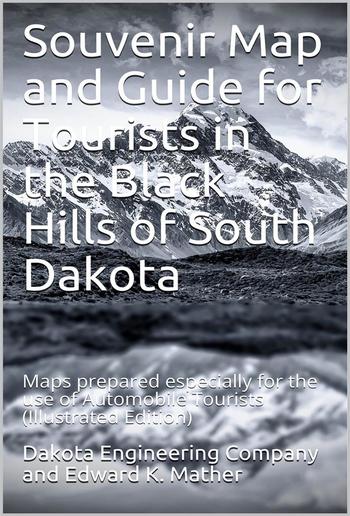
Edward K. Mather - Souvenir Map and Guide for Tourists in the Black Hills of South Dakota / Maps prepared especially for the use of Automobile Tourists
Souvenir Map and Guide for Tourists in the Black Hills of South Dakota / Maps prepared especially for the use of Automobile Tourists
Edward K. Mather
Description
The Black Hills (Lakota: ?e Sápa; Cheyenne: Mo'?hta-vo'honáaeva; Hidatsa: awaxaawi shiibisha) are a small and isolated mountain range rising from the Great Plains of North America in western South Dakota and extending into Wyoming, United States. Black Elk Peak (formerly known as Harney Peak), which rises to 7,244 feet (2,208 m), is the range's highest summit. The Black Hills encompass the Black Hills National Forest. The name "Black Hills" is a translation of the Lakota Pahá Sápa. The hills were so-called because of their dark appearance from a distance, as they were covered in trees.
The region is home to Mount Rushmore National Memorial, Wind Cave National Park, Jewel Cave National Monument, Black Elk Peak, Custer State Park (the largest state park in South Dakota, and one of the largest in the US), Bear Butte State Park, Devils Tower National Monument, and the Crazy Horse Memorial. The Black Hills also hosts the Sturgis Motorcycle Rally each August. The rally was started in 1940 and the 65th Rally in 2005 saw more than 550,000 bikers visit the Black Hills. It is a key part of the regional economy.
The George S. Mickelson Trail is a recently opened multi-use path through the Black Hills that follows the abandoned track of the historic railroad route from Edgemont to Deadwood. The train used to be the only way to bring supplies to the miners in the Hills. The trail is about 110 miles in length, and can be used by hikers, cross-country skiers, and cyclists. The cost is two dollars per day, or ten dollars annually.
Today, the major city in the Black Hills is Rapid City, with an incorporated population of almost 70,000 and a metropolitan population of 125,000. It serves a market area covering much of five states: North and South Dakota, Nebraska, Wyoming, and Montana. In addition to tourism and mining (including coal, specialty minerals, and the now declining gold mining), the Black Hills economy includes ranching (sheep and cattle, primarily, with bison and ratites becoming more common), timber (lumber), Ellsworth Air Force Base, and some manufacturing, including Black Hills gold jewelry, cement, electronics, cabinetry, guns and ammunition.

